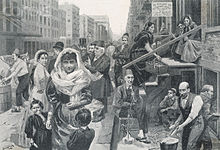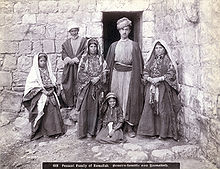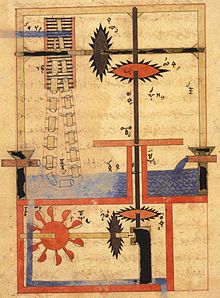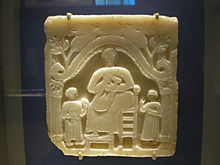
Arab people
About this schools Wikipedia selection
SOS Children have produced a selection of wikipedia articles for schools since 2005. SOS Children has looked after children in Africa for forty years. Can you help their work in Africa?
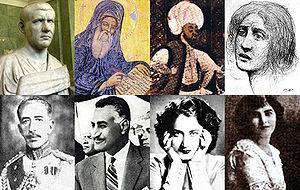 |
||||||||||||||||||||||||||||||
| Philip the Arab • John of Damascus • Al-Kindi • Al-Khansa Faisal I of Iraq • Gamal Abdel Nasser • Asmahan • May Ziade |
||||||||||||||||||||||||||||||
| Total population | ||||||||||||||||||||||||||||||
|---|---|---|---|---|---|---|---|---|---|---|---|---|---|---|---|---|---|---|---|---|---|---|---|---|---|---|---|---|---|---|
| approx. 300 million | ||||||||||||||||||||||||||||||
| Regions with significant populations | ||||||||||||||||||||||||||||||
|
||||||||||||||||||||||||||||||
| Languages | ||||||||||||||||||||||||||||||
|
Arabic, Modern South Arabian, varieties of Arabic |
||||||||||||||||||||||||||||||
| Religion | ||||||||||||||||||||||||||||||
|
Predominantly Islam |
||||||||||||||||||||||||||||||
| Related ethnic groups | ||||||||||||||||||||||||||||||
|
Other Semitic peoples and various Afro-Asiatic peoples |
Arab people, also known as Arabs (Arabic: عرب, ʿarab), are a panethnicity primarily living in the Arab world, which is located in Western Asia and North Africa. They are identified as such on one or more of genealogical, linguistic, or cultural grounds, with tribal affiliations, and intra-tribal relationships playing an important part of Arab identity.
The word "Arab" has had several different, but overlapping, meanings over the centuries (and sometimes even today). In addition to including all Arabized people of the world (with language tending to be the acid test), it has also at times been used exclusively for bedouin (Arab nomads [although a related word, "`a-RAB," with the Arabic letter "alif" in the second syllable, once was sometimes used when this specific meaning was intended] and their now almost entirely settled descendants). It is sometimes used that way colloquially even today in some places. Townspeople once were sometimes called "sons of the Arabs." As in the case of other ethnicities or nations, people identify themselves (or are identified by others) as "Arabs" to varying degrees. This may not be one's primary identity (it tends to compete with country, religion, sect, etc.), and whether it is emphasized may depend upon one's audience.
If the diverse Arab pan-ethnicity is regarded as a single ethnic group, then it constitutes one of the world's largest after Han Chinese.
Etymology
The earliest documented use of the word "Arab" to refer to a people appears in the Monolith Inscription, an Akkadian language record of the 9th century BC Assyrian Conquest of Syria (Arabs had formed part of a coalition of forces opposed to Assyria). Listed among the booty captured by the army of king Shalmaneser III of Assyria in the Battle of Qarqar are 1000 camels of "Gi-in-di-bu'u the ar-ba-a-a" or "[the man] Gindibu belonging to the ʕarab" (ar-ba-a-a being an adjectival nisba of the noun ʕarab).
The most popular Arab account holds that the word 'Arab' came from an eponymous father called Yarab, who was supposedly the first to speak Arabic. Al-Hamdani had another view; he states that Arabs were called GhArab (West in Semitic) by Mesopotamians because Arabs resided to the west of Mesopotamia; the term was then corrupted into Arab. Yet another view is held by Al-Masudi that the word Arabs was initially applied to the Ishmaelites of the "Arabah" valley.
The root of the word has many meanings in Semitic languages including "west/sunset," "desert," "mingle," "merchant," "raven" and are "comprehensible" with all of these having varying degrees of relevance to the emergence of the name. It is also possible that some forms were metathetical from ʿ-B-R "moving around" (Arabic ʿ-B-R "traverse"), and hence, it is alleged, "nomadic."
Identity
Arab identity is defined independently of religious identity, and pre-dates the rise of Islam, with historically attested Arab Christian kingdoms and Arab Jewish tribes. Today, however, most Arabs are Muslim, with a minority adhering to other faiths, largely Christianity. Arabs are generally Sunni, Shia or Sufi Muslims, but currently, 7.1 percent to 10 percent of Arabs are Arab Christians. This figure does not include Christian ethnic groups such as Assyrians, and Syriacs.
The early Arabs were the tribes of Northern Arabia speaking proto Arabic dialects. Although since early days other people became Arabs through an Arabization process that could mean intermarriage with Arabs, adopting the Arabic language and culture, or both. For example, the Ghassanids and the Lakhmids which originated from Southern Semitic speaking Yemen made a major contribution in the creation of the Arabic language. The same process happened all over the Arab world after the spread of Islam by the mixing of Arabs with several other peoples. The Arab cultures went through a mixing process. Therefore every Arab country has cultural specificities which constitute a cultural mix which also originate in local novelties achieved after the arabization took place. However, all Arab countries do also share a common culture in most Aspects: Arts (music, literature, poetry, calligraphy...), Cultural products (Handicrafts, carpets, henne, bronze carving...), Social behaviour and relations (Hospitality, codes of conduct among friends and family...), Customs and superstitions, Some dishes (Shorba, Mloukhia), Traditional clothing, Architecture...
Muslim but non-Arab people, who are about 80 percent of the world's Muslim population, do not form part of the Arab world, but instead comprise what is the geographically larger, and more diverse, Muslim World.
In the USA, Arabs have historically been racially classified as white/Caucasian and, since 1997, by the U.S. Census as well.
Arabic, the main unifying feature among Arabs, is a Semitic language originating in Arabia. From there it spread to a variety of distinct peoples across most of West Asia and North Africa, resulting in their acculturation and eventual denomination as Arabs. Arabization, a culturo-linguistic shift, was often, though not always, in conjunction with Islamization, a religious shift.
With the rise of Islam in the 7th century, and as the language of the Qur'an, Arabic became the lingua franca of the Islamic world. (See Anwar G. Chegne, "Arabic: Its Significance and Place in Arab-Muslim Society," Middle East Journal 19 (Autumn 1965), pp. 447–470.) It was in this period that Arabic language and culture was widely disseminated with the early Islamic expansion, both through conquest and cultural contact.
Arabic culture and language, however, began a more limited diffusion before the Islamic age, first spreading in West Asia beginning in the 2nd century, as Arab Christians such as the Ghassanids, Lakhmids and Banu Judham began migrating north from Arabia into the Syrian Desert, south western Iraq and the Levant.
In the modern era, defining who is an Arab is done on the grounds of one or more of the following two criteria:
- Genealogical: someone who can trace his or her ancestry to the tribes of Arabia – the original inhabitants of the Arabian Peninsula – and the Syrian Desert. This was the definition used in medieval times, for example by Ibn Khaldun, but has decreased in importance over time, as a portion of those of Arab ancestry lost their links with their ancestors' motherland. In the modern era, however, DNA tests have at times proved reliable in identifying those of Arab genealogical descent. For example, it has been found that the frequency of the "Arab marker" Haplogroup J1 collapses suddenly at the borders of Arabic speaking countries.
- Linguistic: someone whose first language, and by extension cultural expression, is Arabic, including any of its varieties. This definition covers more than 450 million people. Certain groups that fulfill this criterion reject this definition on the basis of non-Arab ancestry; such an example may be seen in the way that Egyptians identified themselves in the early 20th century.
The relative importance of these factors is estimated differently by different groups and frequently disputed. Some combine aspects of each definition, as done by Palestinian Habib Hassan Touma, who defines an Arab "in the modern sense of the word", as "one who is a national of an Arab state, has command of the Arabic language, and possesses a fundamental knowledge of Arab tradition, that is, of the manners, customs, and political and social systems of the culture." Most people who consider themselves Arab do so based on the overlap of the political and linguistic definitions. Few people consider themselves Arab based on the political definition without also having Arabic as a first or primary language. Thus Kurds, the Assyrian Christians of Iraq and its surrounds (who primarily speak Mesopotamian Aramaic), Armenians, Shabak, Turcoman, Circassians and Baluch do not identify as Arab, and some Berbers have also rejected the label. Some other ethno-religious minorities within Western Asia and North Africa who do speak Arabic as their primary community language also do not identify with the Arab identity, most notably the Syriac Christian communities such as Maronites of Syria and Lebanon and the Copts of Egypt.
The Arab League, a regional organization of countries intended to encompass the Arab world, defines an Arab as:
An Arab is a person whose language is Arabic, who lives in an Arabic-speaking country, and who is in sympathy with the aspirations of the Arabic-speaking peoples.
According to Sadek Jawad Sulaimanis the former Ambassador of Oman to the United States:
The Arabs are defined by their culture, not by race; and their culture is defined by its essential twin constituents of Arabism and Islam. To most of the Arabs, Islam is their indigenous religion; to all of the Arabs, Islam is their indigenous civilization. The Arab identity, as such, is a culturally defined identity, which means being Arab is being someone whose mother culture, or dominant culture, is Arabism. Beyond that, he or she might be of any ancestry, of any religion or philosophical persuasion, and a citizen of any country in the world. Being Arab does not contradict with being non-Muslim or non-Semitic or not being a citizen of an Arab state.
The relation of ʿarab and ʾaʿrāb is complicated further by the notion of "lost Arabs" al-ʿArab al-ba'ida mentioned in the Qur'an as punished for their disbelief. All contemporary Arabs were considered as descended from two ancestors, Qahtan and Adnan.
Versteegh (1997) is uncertain whether to ascribe this distinction to the memory of a real difference of origin of the two groups, but it is certain that the difference was strongly felt in early Islamic times. Even in Islamic Spain there was enmity between the Qays of the northern and the Kalb of the southern group. The so-called Sabaean or Himyarite language described by Abū Muhammad al-Hasan al-Hamdānī (died 946) appears to be a special case of language contact between the two groups, an originally north Arabic dialect spoken in the south, and influenced by Old South Arabian.
During the Muslim conquests of the 7th and 8th centuries, the Arabs forged an Arab Empire (under the Rashidun and Umayyads, and later the Abbasids) whose borders touched southern France in the west, China in the east, Asia Minor in the north, and the Sudan in the south. This was one of the largest land empires in history. In much of this area, the Arabs spread Islam and the Arabic culture, science, and language (the language of the Qur'an) through conversion and cultural assimilation.
Two references valuable for understanding the political significance of Arab identity: Michael C. Hudson, Arab Politics: The Search for Legitimacy (Yale University Press, 1977), especially Chs. 2 and 3; and Michael N. Barnett, Dialogues in Arab Politics: Negotiations in Regional Order (Columbia University Press, 1998).
Arab population
The table below shows the number of Arab people, including expatriates and some groups that may not be identified as Arabs.
| Flag | Country | Total Population | % Arabs | Notes |
|---|---|---|---|---|
| Egypt | 83,688,164 | 90% | Arabs in Egypt, as in other North African countries differ from Arabs in the Middle East. The classification of Egyptians as Arabs is disputed though the common consensus among Egyptians is that it is tied to the use of Arabic in Egypt, with some Egyptians claiming a distinct " Egyptian" ethnicity. Ninety percent of the population is Eastern Hamitic Arab. Eastern Hamitic Arab is a mixed Hamitic and Arab ancestry. Haplogroup J (aka. the Arab gene) is far from being dominant in Egypt indicating that the absolute majority of Egyptians are not genetically related to the Arabs. (See Haplogroup J (Y-DNA)) | |
| Algeria | 37,367,226 | 70% | Classification as Arab is cultural, not genetic. Almost all Algerians are Berbers in origin (not Arabs). | |
| Morocco | 32,309,239 | 66% | The high level of mixing between Arabs and Berbers makes differentiating between the two ethnicities in Morocco difficult. This figure includes people of mixed Berber and Arab descent. Berber being the majority contribution, and Arab the minority contribution. | |
| Iraq | 31,467,000 | 75-80% | Iraqis are primarily descended from Iraq's original Mesopotamian population. The dialect of Arabic spoken by Iraqis ( Mesopotamian Arabic) has an Aramaic substratum and retains vocabulary of Akkadian and Sumerian provenance. Many Iraqis look to Babylonia and Sumer for their origins and have a sense of Mesopotamian ethnicity, though generally not in antithesis to Arab cultural identification. | |
| Saudi Arabia | 26,246,000 | 90% | Saudis are of Arabian or Bedouin ancestry | |
| Sudan | 25,946,220 | 70% | Sudanese are primarily of native Sudanese ethnic origin, with a small amount of Arab admixture in eastern regions. | |
| Yemen | 24,256,000 | 100% | ||
| Syria | 22,505,000 | 90.3% | Syrians are primarily descended from the ancient peoples of Syria. The Syrian dialect of Arabic has an Aramaic substratum like other dialects of Levantine Arabic and Mesopotamian Arabic. The Aramaeans were one of the peoples of ancient Syria and in antiquity Syria was known as Aram. The Aramaic language of the Aramaeans became the regional lingua franca during the early 1st millennium BC, and it remained so until replaced in this role by Arabic in the 8th century AD. | |
| Tunisia | 10,374,000 | 98% | Almost all of Tunisia's citizenry has Arab and Berber background. Because of the high degree of assimilation Tunisians are often referred to as Arab-Berber. | |
| Chad | 10,329,208 | 15% | ||
| Israel | 7,933,200 | 20.5% | ||
| Libya | 6,546,000 | 97% | Almost all of Libya's citizenry has Arab and Berber background. Because of the high degree of assimilation Libyans are often referred to as Arab-Berber. | |
| Jordan | 6,472,000 | 98% | ||
| Eritrea | 6,086,495 | 2% | Mainly Rashaida | |
| Lebanon | 4,255,000 | 95% | ||
| Palestine | 4,225,710 | 89% | Gaza Strip: 1,657,155, 100% Palestinian Arab, West Bank: 2,568,555, 83% Palestinian Arab and other | |
| Kuwait | 3,030,000 | 80% | ||
| UAE | 4,707,000 | 40% | Less than 20% of the population in the Emirates are citizens, the majority are foreign workers and expatriates. Those holding Emirati citizenship are overwhelmingly Arab. | |
| Oman | 3,090,150 | 90% | ||
| Mauritania | 3,343,000 | 80% | The majority of Mauritania's population are ethnic Moors, an ethnicity with a mix of Arab and Berber ancestry, with a smaller Black African ancestry. Moors make up 80% of the population in Mauritania, the remaining 20% are members of a number of Black African ethnic groups. | |
| Qatar | 1,508,000 | 55% | The native population is a minority in Qatar, making up 20% of the population. The native population is ethnically Arab. An additional 35% of the population is made up of Arabs, mostly Egyptian and Palestinian workers. The remaining population is made up of other foreign workers. | |
| Bahrain | 1,234,571 | 62% | 46.0% of the Bahrain's population are native Bahrainis. Bahrainis are ethnically Arabs. 5.4% are Other Arabs (inc. GCC) | |
| Western Sahara | 663.000 | 80% | Ethnically Western Sahara is inhabited by Arab-berbers. Two languages are widely spoken Hassaniya Arabic and Moroccan Arabic. | |
| Djibouti | 804,000 | 4.5% |
Arab diaspora
The Arab diaspora is a global diaspora distributed across many continents.
| Flag | Country | Number of Arabs | Total Population | % Arabs | Notes |
|---|---|---|---|---|---|
| Brazil | 6,000,000 | 191,241,714 | 3.0% | ||
| Canada | 470,000 | 34,190,000 | 1.4% | ||
| France | 5,500,000 | 65,073,482 | 9,0% | ||
| United States | 311,965,000 | ||||
| Netherlands | 418,000 | 17,196,000 | 2.5% | ||
| Argentina | 1,336,000 | 40,482,000 | 3.3% | ||
| Italy | 800,000 | 60,234,000 | 1.5% | ||
| United Kingdom | 600,000 | 61,113,205 | 1.0% | ||
| Turkey | 1,650,000 | 78,785,548 | 2.1% | ||
| Chile | 700,000 | 16,928,873 | 4.2% |
According to the International Organization for Migration, there are 13 million first-generation Arab migrants in the world, of which 5.8 reside in Arab countries. Arab expatriates contribute to the circulation of financial and human capital in the region and thus significantly promote regional development. In 2009 Arab countries received a total of 35.1 billion USD in remittance in-flows and remittances sent to Jordan, Egypt and Lebanon from other Arab countries are 40 to 190 per cent higher than trade revenues between these and other Arab countries.
The 250,000 strong Lebanese community in West Africa is the largest non-African group in the region.
Arab traders have long operated in Southeast Asia and along the East Africa's Swahili coast. Zanzibar was once ruled by Omani Arabs. Most of the prominent Indonesians, Malaysians, and Singaporeans of Arab descent are Hadhrami people with origins in southern Yemen in the Hadramawt coastal region.
Central Asia and Caucasus
In 1728, a Russian officer described a group of Sunni Arab nomads who populated the Caspian shores of Mughan (in present-day Azerbaijan) and spoke a mixed Turkic-Arabic language. It is believed that these groups migrated to the Caucasus in the 16th century. The 1888 edition of Encyclopædia Britannica also mentioned a certain number of Arabs populating the Baku Governorate of the Russian Empire. They retained an Arabic dialect at least into the mid-19th century, but since then have fully assimilated with the neighbouring Azeris and Tats. Today in Azerbaijan alone, there are nearly 30 settlements still holding the name Arab (for example, Arabgadim, Arabojaghy, Arab-Yengija, etc.).
From the time of the Arab conquest of the Caucasus, continuous small-scale Arab migration from various parts of the Arab world was observed in Dagestan influencing and shaping the culture of the local peoples. Up until the mid-20th century, there were still individuals in Dagestan who claimed Arabic to be their native language, with the majority of them living in the village of Darvag to the north-west of Derbent. The latest of these accounts dates to the 1930s. Most Arab communities in southern Dagestan underwent linguistic Turkicisation, thus nowadays Darvag is a majority-Azeri village.
According to the History of Ibn Khaldun, the Arabs that were once in Central Asia have been either killed or have fled the Tatar invasion of the region, leaving only the locals . However, today many people in Central Asia identify as Arabs. Most Arabs of Central Asia are fully integrated into local populations, and sometimes call themselves the same as locals (for example, Tajiks, Uzbeks) but they use special titles to show their Arabic origin such as Sayyid, Khoja or Siddiqui.
South Asia
There are only two communities with the self-identity Arab in South Asia, the Chaush of the Deccan region and the Chavuse of Gujerat, who are by and large descended of Hadhrami migrants who settled in these two regions in the 18th Centuries. However, both these communities no longer speak Arabic, although with the Chaush, there has been re-immigration to the Gulf States, and re-adoption of Arabic by these immigrants. In South Asia, claiming Arab ancestry is considered prestigious, and many communities have origin myths with claim to an Arab ancestry. Examples include the Mappilla of Kerala, Labbai of Tamil Nadu and Kokan of Maharashtra. These communities all allege an Arab ancestry, but none speak Arabic and follow the customs and traditions of the Hindu majority. Among Muslims of North India, Arabs in Pakistan Pakistan and Afghanistan, there are groups who claim the status of Sayyid, have origin myths that allege descent from the Prophet Mohammmad. None of these Sayyid families speak Arabic or follow Arab customs or traditions.
Iranian Arab communities are also found in Khuzestan Province.
History
Pre-Islamic
Semitic origin

There is a consensus that the Semitic peoples originated from Arabian peninsula. It should be pointed out that these settlers were not Arabs or Arabic speakers. Early non Arab Semitic peoples from the Ancient Near East, such as the Arameans, Akkadians ( Assyrians and Babylonians), Amorites, Israelites, Eblaites, Ugarites and Canaanites, built civilizations in Mesopotamia and the Levant; genetically, they often interlapped and mixed. Slowly, however, they lost their political domination of the Near East due to internal turmoil and attacks by non-Semitic peoples. Although the Semites eventually lost political control of Western Asia to the Persian Empire, the Aramaic language remained the lingua franca of Assyria, Mesopotamia and the Levant. Aramaic itself was replaced by Greek as Western Asia's prestige language following the conquest of Alexander III of Macedon, though it survives to this day among Assyrian (aka Chaldo-Assyrian) Christians and Mandeans in Iraq, northeast Syria, southeast Turkey and northwest Iran..
Early history
The first written attestation of the ethnonym "Arab" occurs in an Assyrian inscription of 853 BCE, where Shalmaneser III lists a King Gindibu of mâtu arbâi (Arab land) as among the people he defeated at the Battle of Karkar. Some of the names given in these texts are Aramaic, while others are the first attestations of Ancient North Arabian dialects. In fact several different ethnonyms are found in Assyrian texts that are conventionally translated "Arab": Arabi, Arubu, Aribi and Urbi. Many of the Qedarite queens were also described as queens of the aribi. The Hebrew Bible occasionally refers to Aravi peoples (or variants thereof), translated as "Arab" or "Arabian." The scope of the term at that early stage is unclear, but it seems to have referred to various desert-dwelling Semitic tribes in the Syrian Desert and Arabia. Arab tribes came into conflict with the Assyrians during the reign of the Assyrian king Ashurbanipal, and he records military victories against the powerful Qedar tribe among others.
Medieval Arab genealogists divided Arabs into three groups:
- "Ancient Arabs", tribes that had vanished or been destroyed, such as ʿĀd and Thamud, often mentioned in the Qur'an as examples of God's power to destroy those who did not believe and follow their prophets and messengers.
- "Pure Arabs" of South Arabia, descending from Qahtan. The Qahtanites (Qahtanis) are said to have migrated from the land of Yemen following the destruction of the Ma'rib Dam (sadd Ma'rib).
- The "Arabized Arabs" (musta`ribah) of centre and North Arabia, descending from Ishmael the elder son of Abraham. The Book of Genesis narrates that God promised Hagar to beget from Ishmael twelve princes and turn him to a great nation.( Genesis 17:20) The Book of Jubilees, in the other hand, claims that the sons of Ishmael intermingled with the 6 sons of Keturah, from Abraham, and their descendants were called Arabs and Ishmaelites:
Book of Jubilees 20:13 And Ishmael and his sons, and the sons of Keturah and their sons, went together and dwelt from Paran to the entering in of Babylon in all the land which is towards the East facing the desert. And these mingled with each other, and their name was called Arabs, and Ishmaelites.
Ibn Khaldun's Muqaddima distinguishes between sedentary Muslims who used to be nomadic Arabs and the Bedouin nomadic Arabs of the desert. He used the term "formerly-nomadic" Arabs and refers to sedentary Muslims by the region or city they lived in, as in Egyptians, Spaniards and Yemenis. The Christians of Italy and the Crusaders preferred the term Saracens for all the Arabs and Muslims of that time. The Christians of Iberia used the term Moor to describe all the Arabs and Muslims of that time. Muslims of Medina referred to the nomadic tribes of the deserts as the A'raab, and considered themselves sedentary, but were aware of their close racial bonds. The term "A'raab' mirrors the term Assyrians used to describe the closely related nomads they defeated in Syria.
The Qur'an does not use the word ʿarab, only the nisba adjective ʿarabiy. The Qur'an calls itself ʿarabiy, "Arabic", and Mubin, "clear". The two qualities are connected for example in ayat 43.2–3, "By the clear Book: We have made it an Arabic recitation in order that you may understand". The Qur'an became regarded as the prime example of the al-ʿarabiyya, the language of the Arabs. The term ʾiʿrāb has the same root and refers to a particularly clear and correct mode of speech. The plural noun ʾaʿrāb refers to the Bedouin tribes of the desert who resisted Muhammad, for example in ayat 9.97, alʾaʿrābu ʾašaddu kufrān wa nifāqān "the Bedouin are the worst in disbelief and hypocrisy".
Based on this, in early Islamic terminology, ʿarabiy referred to the language, and ʾaʿrāb to the Arab Bedouins, carrying a negative connotation due to the Qur'anic verdict just cited. But after the Islamic conquest of the 8th century, the language of the nomadic Arabs became regarded as the most pure by the grammarians following Abi Ishaq, and the term kalam al-ʿArab, "language of the Arabs", denoted the uncontaminated language of the Bedouins.
Classical kingdoms
Proto-Arabic, or Ancient North Arabian, texts give a clearer picture of the Arabs' emergence. The earliest are written in variants of epigraphic south Arabian musnad script, including the 8th century BCE Hasaean inscriptions of eastern Saudi Arabia, the 6th century BCE Lihyanite texts of southeastern Saudi Arabia and the Thamudic texts found throughout Arabia and the Sinai (not in reality connected with Thamud).
The Nabataeans were nomadic newcomers who moved into territory vacated by the Edomites – Semites who settled the region centuries before them. Their early inscriptions were in Aramaic, but gradually switched to Arabic, and since they had writing, it was they who made the first inscriptions in Arabic. The Nabataean Alphabet was adopted by Arabs to the south, and evolved into modern Arabic script around the 4th century. This is attested by Safaitic inscriptions (beginning in the 1st century BCE) and the many Arabic personal names in Nabataean inscriptions. From about the 2nd century BCE, a few inscriptions from Qaryat al-Faw (near Sulayyil) reveal a dialect which is no longer considered "proto-Arabic", but pre-classical Arabic. Five Syriac inscriptions mentioning Arabs have been found at Sumatar Harabesi, one of which has been dated to the 2nd century CE.
Late kingdoms
The Ghassanids, Lakhmids and Kindites were the last major migration of non-Muslims out of Yemen to the north.
- The Ghassanids increased the Semitic presence in the then Hellenized Syria, the majority of Semites were Aramaic peoples. They mainly settled in the Hauran region and spread to modern Lebanon, Palestine and East Jordan.
Greeks and Romans referred to all the nomadic population of the desert in the Near East as Arabi. The Romans called Yemen " Arabia Felix". The Romans called the vassal nomadic states within the Roman Empire " Arabia Petraea" after the city of Petra, and called unconquered deserts bordering the empire to the south and east Arabia Magna.
- The Lakhmids as a dynasty inherited their power from the Tanukhids, the mid Tigris region around their capital Al-Hira they ended up allying with the Sassanid against the Ghassanids and the Byzantine Empire. The Lakhmids contested control of the Central Arabian tribes with the Kindites with the Lakhmids eventually destroying Kinda in 540 after the fall of their main ally Himyar. The Persians Sassanids dissolved the Lakhmid dynasty in 602, being under puppet kings, then under their direct control.
- The Kindites migrated from Yemen along with the Ghassanids and Lakhmids, but were turned back in Bahrain by the Abdul Qais Rabi'a tribe. They returned to Yemen and allied themselves with the Himyarites who installed them as a vassal kingdom that ruled Central Arbia from "Qaryah Dhat Kahl" (the present-day called Qaryat al-Faw) in Central Arabia. They ruled much of the Northern/Central Arabian peninsula, till they were destroyed by the Lakhmid king Al-Mundhir, and his son 'Amr
Islamic
Arab Caliphate
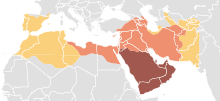
Rashidun Era (632-661)
After the death of Muhammad in 632, Rashidun armies launched campaigns of conquest, establishing the Caliphate, or Islamic Empire, one of the largest empires in history. It was larger and lasted longer than the previous Arab empires of Queen Mawia or the Palmyrene Empire which was predominantly Syriac rather than Arab. The Rashidun state was a completely new state and not a mere imitation of the earlier Arab kingdoms such as the Himyarite, Lakhmids or Ghassanids, although it benefited greatly from their art, administration and architecture.
Umayyad Era (661-750)
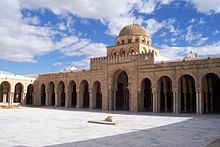
In 661 Caliphate turned to the hands of the Umayyad dynasty, Damascus was established as the Muslim capital. They were proud of their Arab ancestry and sponsored the poetry and culture of pre-Islamic Arabia. They established garrison towns at Ramla, ar-Raqqah, Basra, Kufa, Mosul and Samarra, all of which developed into major cities.
Caliph Abd al-Malik established Arabic as the Caliphate's official language in 686. This reform greatly influenced the conquered non-Arab peoples and fueled the Arabization of the region. However, the Arabs' higher status among non-Arab Muslim converts and the latter's obligation to pay heavy taxes caused resentment. Caliph Umar II strove to resolve the conflict when he came to power in 717. He rectified the situation, demanding that all Muslims be treated as equals, but his intended reforms did not take effect as he died after only three years of rule. By now, discontent with the Umayyads swept the region and an uprising occurred in which the Abbasids came to power and moved the capital to Baghdad.
Umayyads expanded their Empire westwards capturing North Africa from the Byzantines. Prior to the Arab conquest, North Africa was inhibited by various people including Punics, Vandals and Greeks. It was not until the 11th century that the Maghreb saw a large influx of ethnic Arabs. Starting with the 11th century, the Arab bedouin Banu Hilal tribes migrated to the West. Having been sent by the Fatimids to punish the Berber Zirids for abandoning Shiism, they travelled westwards. The Banu Hilal quickly defeated the Zirids and deeply weakened the neighboring Hammadids. Their influx was a major factor in the Arabization of the Maghreb, Although Berbers would rule the region until the 16th century (under such powerful dynasties as the Almoravids, the Almohads, Hafsids, etc.), the arrival of these tribes would eventually help to Arabize much of it ethnically in addition to the linguistic and political impact on the none-Arabs there. With the collapse of the Umayyad state in 1031 AD, Islamic Spain was divided into small kingdoms.
Abbassid Era (750-1513)
Abbasids let a revolt against the Umayyads and defeated them in the Battle of the Zab effectively ending their rule in all part of the Empire except Al-Andalus. The Abbasids descendants of Muhammad's uncle Abbas, but unlike the Umayyads, they had the support of non-Arab subjects of the Umayyads. where Umayyads treated non-Arabs in contempt. Abbasids ruled for 200 years before they lost their central control when Wilayas began to fracture, afterwards in the 1190s there was a revival for their power which was put to end by the Mongols who conquered Baghdad and killed the Caliph, members of the Abbasid royal family escaped the massacre and resorted to Cairo, which fractured from the Abbasid rule two years earlier, the Mamluk generals were taking the political side of the kingdom while Abbasid Caliphs were engaged in civil activities and continued patronizing science, arts and literature.
- Fractured Entities:
- Fatimids
- Ayyubid dynasty
Ottoman Caliphate
Arabs were ruled by Ottoman sultans from 1513 to 1918. Ottomans defeated the Mamluk Sultanate in Cairo, and ended the Abbasid Caliphate when they choose to bear the title of Caliph. Arabs did not feel the change of administration because Ottomans modeled their rule after the previous Arab administration systems. After World War I when the Ottoman Empire was overthrown by the British Empire, former Ottoman colonies were divided up between the British and French as Mandates.
Modern
Arabs in modern times live in the Arab world, which comprises 22 countries in the Middle East and North Africa. They are all modern states and became significant as distinct political entities after the fall and dissolution of the Ottoman Empire (1908–1918).
Religion
Arab Muslims are generally Sunni or Shia, one exception being the Ibadis, who predominate in Oman and can be found as small minorities in Algeria and Libya (mostly Berbers). Arab Christians generally follow Eastern Churches such as the Coptic Orthodox, Greek Orthodox and Greek Catholic churches and the Maronite church and others. In Iraq most Christians are Assyrians rather than Arabs, and follow the Assyrian Church of the East, Syriac Orthodox and Chaldean Church. The Greek Catholic churches and Maronite church are under the Pope of Rome, and a part of the larger worldwide Catholic Church. There are also Arab communities consisting of Druze and Baha'is.
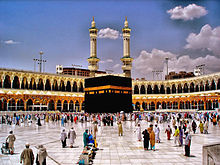
Before the coming of Islam, most Arabs followed a pagan religion with a number of deities, including Hubal, Wadd, Allāt, Manat, and Uzza. A few individuals, the hanifs, had apparently rejected polytheism in favour of monotheism unaffiliated with any particular religion. Some tribes had converted to Christianity or Judaism. The most prominent Arab Christian kingdoms were the Ghassanid and Lakhmid kingdoms. When the Himyarite king converted to Judaism in the late 4th century, the elites of the other prominent Arab kingdom, the Kindites, being Himyirite vassals, apparently also converted (at least partly). With the expansion of Islam, polytheistic Arabs were rapidly Islamized, and polytheistic traditions gradually disappeared.
Today, Sunni Islam dominates in most areas, overwhelmingly so in North Africa. Shia Islam is dominant in southern Iraq and Lebanon. Substantial Shi'a populations exist in Saudi Arabia, Kuwait, northern Syria, the al-Batinah region in Oman, and in northern Yemen. The Druze community is concentrated in Lebanon, Israel and Syria. Many Druze claim independence from other major religions in the area and consider their religion more of a philosophy. Their books of worship are called Kitab Al Hikma (Epistles of Wisdom). They believe in reincarnation and pray to five messengers from God.
Christians make up 5.5% of the population of the Near East. In Lebanon they number about 39% of the population. In Syria, Christians make up 16% of the population. In British Palestine estimates ranged as high as 25%, but is now 3.8% due largely to the vast immigration of Jews into Israel following Israel's independence, and the 1948 Palestinian exodus. In West Bank and in Gaza, Arab Christians make up 8% and 0.8% of the populations, respectively. In Egypt, Christians number about 10% of the population. In Iraq, Christians constitute today up 3-4%, the number dropped from over 5% after Iraq war, a few of these are Arabs. In Israel, Arab Christians constitute 2.1% (roughly 9% of the Arab population). Arab Christians make up 8% of the population of Jordan. Most North and South American Arabs are Christian, as are about half of Arabs in Australia who come particularly from Lebanon, Syria, and the Palestinian territories. One well known member of this religious and ethnic community is Saint Abo, martyr and the patron saint of Tbilisi, Georgia.
Jews from Arab countries – mainly Mizrahi Jews and Yemenite Jews – are today usually not categorised as Arab. Sociologist Philip Mendes asserts that before the anti-Jewish actions of the 1930s and 1940s, overall Iraqi Jews "viewed themselves as Arabs of the Jewish faith, rather than as a separate race or nationality". Also, prior to the massive Sephardic emigrations to the Middle East in the 16th and 17th centuries, the Jewish communities of what are today Syria, Iraq, Israel, Lebanon, Egypt and Yemen were known by other Jewish communities as Musta'arabi Jews or "like Arabs". Prior to the emergence of the term Mizrahi, the term " Arab Jews" was sometimes used to describe Jews of the Arab world. The term is rarely used today. The few remaining Jews in the Arab countries reside mostly in Morocco and Tunisia. From the late 1940s to the early 1960s, following the creation of the state of Israel, most of these Jews fled their countries of birth and are now mostly concentrated in Israel. Some immigrated to France, where they formed a large Jewish community, that outnumbered Jews in the United States, but relatively small compared to European Jews. See Jewish exodus from Arab lands.
Urbanization
Dozens of large cities and hundreds of towns reflect pronounced urban character of the Arab world; in most of the countries about 70 percent of people are urban dwellers.
Science
The Islamic Golden Age was inaugurated by the middle of the 8th century by the ascension of the Abbasid Caliphate and the transfer of the capital from Damascus to the newly founded city Baghdad. The Abbassids were influenced by the Qur'anic injunctions and hadith such as "The ink of the scholar is more holy than the blood of martyrs" stressing the value of knowledge. During this period the Muslim world became an intellectual centre for science, philosophy, medicine and education as the Abbasids championed the cause of knowledge and established the " House of Wisdom" (Arabic: بيت الحكمة) in Baghdad. Rival Muslim dynasties such as the Fatimids of Egypt and the Umayyads of al-Andalus were also major intellectual centres with cities such as Cairo and Córdoba rivaling Baghdad.
Culture
Arab culture is a term that draws together the common themes and overtones found in the Arab countries, especially those of the Middle-Eastern countries. This region's distinct religion, art, and food are some of the fundamental features that define Arab culture.
Art
Arabic Art includes a wide range or artistic components, it can be Arabic miniature, calligraphy or Arabesque.
Architecture
Arab Architecture has a deep diverse history, it dates to the dawn of the history in pre-Islamic Arabia. Each of it phases largely an extension of the earlier phase, it left also heavy impact on the architecture of other nations.
Music
Arabic music is the music of Arab people or countries, especially those centered on the Arabian Peninsula. The world of Arab music has long been dominated by Cairo, a cultural centre, though musical innovation and regional styles abound from Morocco to Saudi Arabia. Beirut has, in recent years, also become a major centre of Arabic music. Classical Arab music is extremely popular across the population, especially a small number of superstars known throughout the Arab world. Regional styles of popular music include Algerian raï, Moroccan gnawa, Kuwaiti sawt, Egyptian el gil and Arabesque-pop music in Turkey.
Literature
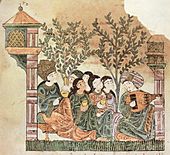
Arabic literature spans for over two millennium, it has three phases, the pre-Islamic, Islamic and modern. Arabic literature had contributions by thousands of figures, many of them are not only poets but are celebrates in other fields such as politicians, scientists and scholars among others.
Genetics
Y-Chromosome
Listed here are the human Y-chromosome DNA haplogroups in main regions of the Arab world (Maghreb, Mashriq and Arabian peninsula).
| Haplogroup | n | A | B | C | DE | E1a | E1b1a | E1b1b1 | E1b1b1a | E1b1b1a1 | E1b1b1a1b | E1b1b1a2 | E1b1b1a3 | E1b1b1a4 | E1b1b1b | E1b1b1c | F | G | H | I | J1 | J2 | K | L | N | O | P,R | Q | R1a1 | R1b | R1b1a | R1b1b | R2 | T |
| Marker | M33 | M2 | M35 | M78 | V12 | V32 | V13 | V22 | V65 | M81 | M34 | M89 | M201 | M69 | M343 | V88 | M269 | M70 | ||||||||||||||||
| Maghreb | ||||||||||||||||||||||||||||||||||
| Sahara/Mauritania | 189 | - | 0.53 | - | - | 5.29 | 6.88 | - | - | - | - | - | - | - | 55.56 | 11.11 | - | - | - | - | 13.23 | - | - | - | - | - | - | - | - | - | 6.88 | 0.53 | - | - |
| Morocco | 760 | 0.26 | 0.66 | - | - | 2.76 | 3.29 | 4.21 | 0.79 | 0.26 | - | 0.26 | 1.84 | 3.68 | 67.37 | 0.66 | 0.26 | 0.66 | - | 0.13 | 6.32 | 1.32 | 0.53 | - | - | - | 0.26 | - | - | - | 0.92 | 3.55 | - | - |
| Algeria | 156 | - | - | - | - | 0.64 | 5.13 | 0.64 | 1.92 | 0.64 | - | 0.64 | 1.28 | 1.92 | 44.23 | 1.28 | 3.85 | - | - | - | 21.79 | 4.49 | 0.64 | - | - | - | - | 0.64 | 0.64 | - | 2.56 | 7.04 | - | - |
| Tunisia | 601 | - | 0.17 | - | - | 0.5 | 0.67 | 1.66 | - | - | - | - | 3 | 3.16 | 62.73 | 1.16 | 2.66 | 0.17 | - | 0.17 | 16.64 | 2.83 | 0.33 | - | - | - | 0.33 | - | 0.5 | - | 1.83 | 0.33 | - | 1.16 |
| Libya | 83 | - | - | - | - | - | 38.55 | - | - | - | - | 2.41 | - | 4.82 | 45.78 | - | - | - | - | - | - | - | - | - | - | - | 2.41 | - | - | - | 6.02 | - | - | - |
| Machrik | ||||||||||||||||||||||||||||||||||
| Egypt | 370 | 1.35 | - | - | - | 0.54 | 2.43 | 3.24 | 0.81 | 7.03 | 1.62 | 0.81 | 9.19 | 2.43 | 11.89 | 6.76 | 1.08 | 5.68 | - | 0.54 | 20.81 | 6.75 | 0.27 | 0.81 | - | 0.27 | 0.54 | 0.27 | 2.16 | - | 2.97 | 2.97 | 0.54 | 6.22 |
| Jordan, Syria, Lebanon, Iraq, Palestine | 2741 | 0.18 | 0.04 | 0.04 | - | 0.33 | 0.62 | 0.44 | - | - | - | 1.24 | 8.72 | - | 0.84 | 5.36 | 0.15 | 5.47 | - | 2.84 | 30.83 | 21.05 | 0.69 | 3.43 | 0.15 | 0.07 | 0.66 | 1.2 | 3.39 | 0.36 | 5.47 | 1.97 | 0.47 | 3.98 |
| Arabian Peninsula | 618 | 0.16 | 0.81 | 0.97 | 0.81 | 0.32 | 5.66 | 1.94 | 0.49 | - | - | 0.32 | 2.43 | - | 0.16 | 5.66 | 1.29 | 2.91 | 2.1 | - | 44.01 | 11.32 | 4.37 | 2.27 | - | 0.65 | 0.32 | 1.46 | 6.31 | 0.16 | - | 2.43 | 0.16 | 0.49 |

